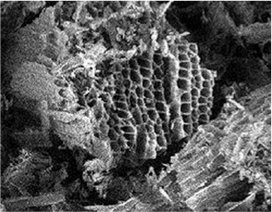
Carbon — Potassium Permanganate Filters
Activated Carbon Efficiency
It’s a GAS!
Particle Air Filters (including HEPAs) do not filter gases. A Particle Air Filter may capture particles that are out-gassing odors. ALL odors are gasses.How do we filter most gases? With adsorption or chemisorption filters.
Adsorption
Activated Carbon is the most common media of adsorption filters.Why? Because activated carbon has a tremendous surface area and can adsorb most organic chemicals. Van der Waal’s Forces include the attraction and capture of gas or liquid molecules to the surface of a solid. Surface area is critical. 1 gram of activated carbon has over 5,382 ft2 of surface area. Just 3 lbs have over 160 acres of surface area.
Activated Carbon Efficiency
Excellent Adsorption — 10–25% of weight.Types of Odors: Adhesives, Antiseptics, Asphalt, Burned Foods & Fats, Charred Materials, Cigar and Cigarette Smoke, Cleaning Compounds, Decaying Materials, Diesel Fumes, Fish, Gasoline, Naptha, Ozone, Paint & Varnish, Pet, Sewer, Tar, Turpentine.
Some Specific Chemicals & Compounds:A — Acetic Acid, Acetic Anhydride, Acrylic Acid, Acrylonitrile, Amyl Acetate, Amyl Alcohol, Amyl Ether, Aniline. B — Benzene, Bromine, Butanone, Butyl Acetate, Butyl Alcohol, Butyl Cellosolve, Butyl Chloride, Butyl Ether, Butyric Acid. C — Camphor, Caprylic Acid, Carbolic Acid, Carbon Disulfide, Carbon Tetrachloride, Cellosolve, Cellosolve Acetate, Chlorobenzene, Chlorobuadiene, Chloroform, Chloronitropropane, Chloropicrin, Creosote, Cresol, Crotonaldehyde, Cyclohexane, Cyclohexanol, Cyclohexanone, Cyclohexene. D — Decane, Dibromoethane, Dichlorobenzene, Dichlorodifluoromethane, Dichloroethane, Dichloroethylene, Dichloroethyl Ether, Dichloronitroethane, Dichloropropane, Dichlorotetrafluroethane, Diethyl Ketone, Dimethylaniline, Dimethyl sulfate, Dioxane, Dipropyl Keytone. E — Ethyl Acetate, Ethyl Acrylate, Ethyl Alcohol, Ethyl Benzene, Ethyl Bromide, Ethyl Silicate, Ethylene Chlorohydrin, Ethylene Dichloride, Eucalyptol. H — Heptane, Heptylene. I — Indole, Iodine, Iodoform, Isophorone, Isopropyl Acetate, Isopropyl Alcohol, Isopropyl Ether. K — Kerosene. L — Lactic Acid. M — Menthol, Mercaptans, Mesityl Oxide, Methyl Acrylate, Methyl· Butyl Ketone, Methyl Cellosolve, Methyl Cellosolve Acetate, Methyl Chloroform, Methyl Ethyl Ketone, Methyl Mercaptan, Methylcyclohexane, Methylcyclohexanol, Methylcyclohexane, Methylene Chloride, Monochlorobenzene, Monoflurotrichloromethane. P — Palmitic Acid, Paradichlorobenzene, Pentanone, Perchloroethylene, Phenol, Propionic Acid, Propyl Acetate, Propyl Alcohol, Propyl Chloride, Propyl Ether, Propyl Mercaptan, Putrescine, Pyridine. S — Skatole, Styrene Monomer, Sulfuric Acid. T — Tetrachloroethylene, Toluene, Toluidine, Trichloroethylene, Trichloroethane, Turpentine. U — Urea, Uric Acid. V — Valerie Acid, Valericaldehyde. X — Xylene.
Good Adsorption — 10–25% of weight.Types of Odors: Animals, Anesthetics, Bleaching Solutions, Coal Smoke, Combustion, Corrosive Gases, Film Processing, Inorganic Chemicals, Mold, Solvents, Volatile Chemicals. Specific Chemicals & Compounds:A — Acetone, Acrolein. B — Borane, Butadiene, Butyraldehyde. C — Chlorine. D — Dichloromonofluormethane, Diethyl amine. E — Ether, Ethyl Amine, Ethyl Chloride, Ethyl Ether, Ethyl Formate, Ethyl Inercaptan, Ethylene Oxide. H — Hexane, Hexylene, Hexyne, Hydrogen Bromide, Hydrogen Cyanide, Hydrogen Iodide, Hydrogen Sulfide. I — Isoprene. M — Methyl Acetate, Methyl Alcohol, Methyl Bromide, Methyl Chloride, Methyl Ether, Methyl Formate. N — Nitric Acid. P — Pentane, Pentylene, Pentyne, Phosgene, Propionaldehyde. V — Vinyl Chloride. Activated Carbon is not effective on glycols, strong acids and bases, metals and some inorganics, such as lithium, sodium, iron, lead, arsenic, fluorine, and boric acid.Chemisorption is a kind of Adsorption which involves a chemical reaction between the surface and the adsorbate. Chemically bonded Adsorption.Potassium Permanganate is an inorganic chemical compound that is a strong oxidizing agent that doesn’t have a toxic end product. Excellent Chemisorption Acetic Acid, Aldehydes, Ethylene, Formaldehyde, Gluteraldehyde, Hydrogen Cyanide, Hydrogen Sulfide, Mercaptans, Nitric Oxide, Nitrogen Dioxide, Sulfur Dioxide, Sulfur Trioxide. The combination of Activated Carbon and Potassium Permanganate provides the widest range of odor removal.




